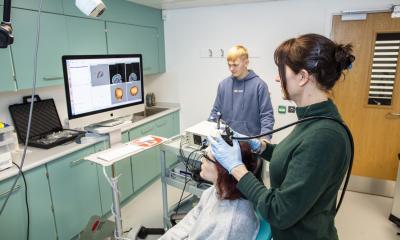
Image source: Adobe Stock/Axel Kock
Article • High-intensity focused ultrasound
HIFU ablation treatment for benign thyroid nodules
High-intensity focused ultrasound (HIFU) ablation is a noninvasively treatment for benign thyroid nodules that are causing distress to patients. Brian H. H. Lang, MD, Clinical Professor in the Department of Surgery at the University of Hong Kong, and chief of the Division of Endocrine Surgery at Queen Mary Hospital, is a preeminent investigator, proponent, and pioneer of this technique. He discussed this still novel thermal ablation treatment at the 8th International Symposium on Focused Ultrasound held in Bethesda, Maryland, US.
Report: Cynthia E. Keen
Up to 60% of the world’s population has thyroid nodules, most of which are benign and cause no problems. However, between 10% to 15% can progress and grow to a size that causes discomfort, cosmetic disfigurement, and/or obstructive symptoms. In these cases, surgical resection or thermal ablation is required to shrink the volume and size of the nodule. Types of thermal ablation include HIFU ablation, radiofrequency ablation, laser ablation, microwave ablation, and ethanol ablation, all of which are non-invasive. Ablation is a safe, tolerable, less expensive, outpatient procedure that does not require general anaesthesia. Organ function is preserved and kept intact, compared to surgery, which removes portions of the thyroid.
Size matters (and so does growth)

© HKU Med
‘HIFU ablation is appropriate for patients with small-to-medium sized, benign solid nodules greater than 40 mm in size or which are experiencing interval nodule growth greater than 20% in one year. The distance from the skin to the center of the nodule should not be less than 7 mm or greater than 30 mm, because HIFU can cause skin burns if too close and the ultrasound energy will dissipate and not be as effective if too far,’ explained Lang, who has performed more than 600 of these procedures.
Lang said that the HIFU treatment utilizes multiple high-energy ultrasound waves focused at one particular area to cause intense vibrations of tissue, generating heat that causes necrosis at the target location. Thermal injury occurs when tissue temperature reaches 56°C for a duration of one second or more, causing protein denaturation and coagulation necrosis. Acoustic cavitation – the formation of microbubbles which expand and collapse – causes mechanical damage to nearby cells, resulting in coagulative necrosis and apoptosis. Cell arrest also occurs, activating immune cells that detect and destroy tumour cells.
The total on-beam HIFU treatment time for a 3 cm nodule takes between 30-45 minutes, with a patient spending 4-6 hours at an outpatient clinic. Two sequential treatments six months apart are recommended for larger nodules.
Shrinkage may vary
Thyroid nodule shrinkage following HIFU ablation is not uniform, and the reasons for this are still being investigated. ‘HIFU can generally achieve a volume shrinkage between 45% to 70%, with the smallest nodules having the greatest shrinkage,’ said Lang. ’80% of my patients had a greater-than-50% shrinkage at six months. Also, the number and severity of pressure symptoms tend to be significantly reduced at 12 months.’ The extent and duration of shrinkage beyond two years is not yet known and is also currently being investigated.
Great care must be taken to prevent heat injury to the carotid artery, trachea, and recurrent laryngeal nerve. Skin burns are the most commonly reported side effect; transient vocal cord palsy occurs in less than 5% of patients. Lang and his colleagues at the University of Hong Kong have conducted numerous research investigations of the usage and efficacy of HIFU as a treatment for benign thyroid nodules. Noteworthy clinical trial findings include:
- The addition of percutaneous ethanol injection (PEI) in combination with HIFU ablation in benign thyroid nodules is associated with a significantly better six-month efficacy then HIFU alone and has a comparable safety profile.1
- HIFU ablation is a feasible treatment in patients take an anti-coagulation or anti-platelet agent during treatment. It might be preferable to surgery in patients who continuously require an anti-coagulation or anti-platelet agent.2
- For the 85% of patients who experience pain during HIFU ablation, the additional administration of a perithyroidal lignocaine infusion (PLI) in conjunction with intravenous doses of a sedative and an opioid provides greater pain relief. A randomized 205-person study identified lower body mass index (BMI) and older age as independent indicators of experiencing less pain.3
- Two sequential HIFU ablation treatments six months apart generate more nodule shrinkage than a single treatment of large thyroid nodules (with a volume of at least 20 mL and up to 50 mm in diameter). Patients undergoing two treatments are not at greater risks of treatment-related side effects.4
Profile:
Brian Hung-Hin Lang, MD, is the Li Shu Fan Medical Foundation Professor in Surgery at School of Clinical Medicine at the University of Hong Kong, and also serves as its Director of the Surgical Skills Training Center. He is the chief of the Division of Endocrine Surgery at Queen Mary Hospital in Hong Kong, specializing in thyroid, parathyroid, adrenal diseases, and ablation of thyroid nodules. Lang has pioneered the use of high intensity focused ultrasound (HIFU) in the treatment of benign thyroid disease.
References:
- Combining high-intensity focused ultrasound (HIFU) ablation with percutaneous ethanol injection (PEI) in the treatment of benign thyroid nodules; European Radiology 2021
- High intensity focused ultrasound (HIFU) ablation of benign thyroid nodule is safe and efficacious in patients who continue taking an anti-coagulation or anti-platelet agent in the treatment period; International Journal of Hyperthermia
- Effect of perithyroidal lignocaine infusion (PLI) to pain experienced during high-intensity focused ultrasound (HIFU) ablation of benign thyroid nodules; European Radiology 2019
- Two sequential applications of high-intensity focused ultrasound (HIFU) ablation for large benign thyroid nodules; European Radiology 2019
23.01.2023











